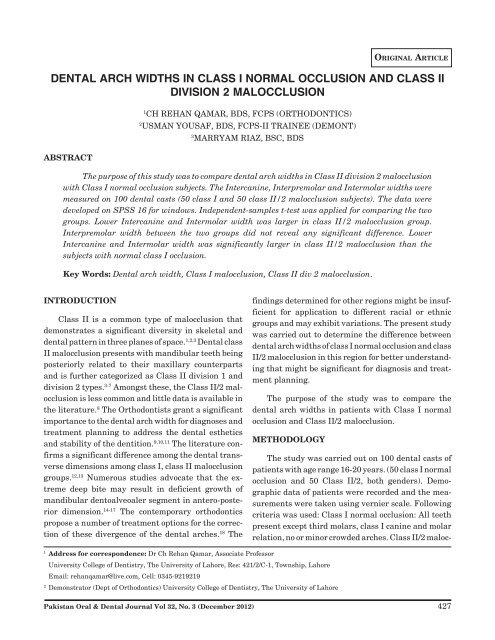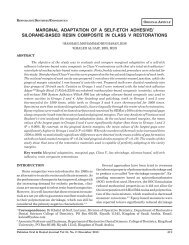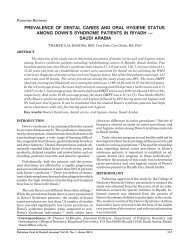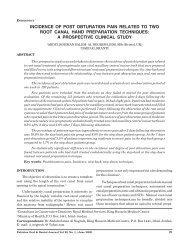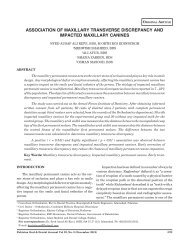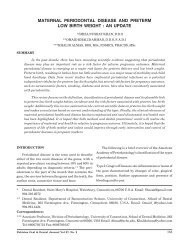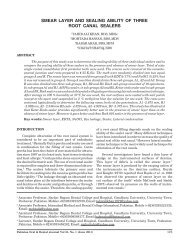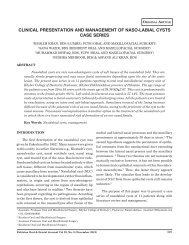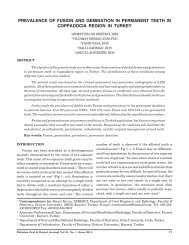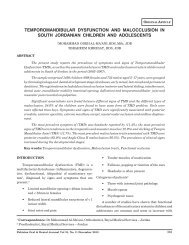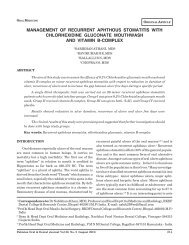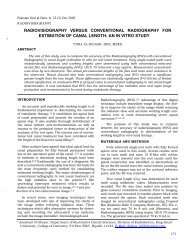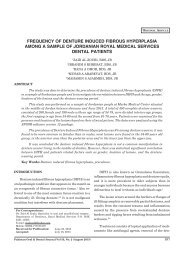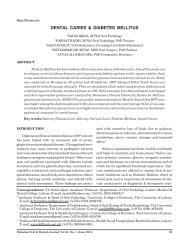dental arch widths in class i normal occlusion and class ii division 2 ...
dental arch widths in class i normal occlusion and class ii division 2 ...
dental arch widths in class i normal occlusion and class ii division 2 ...
You also want an ePaper? Increase the reach of your titles
YUMPU automatically turns print PDFs into web optimized ePapers that Google loves.
Dental Arch Widths<br />
ORIGINAL ARTICLE<br />
DENTAL ARCH WIDTHS IN CLASS I NORMAL OCCLUSION AND CLASS II<br />
DIVISION 2 MALOCCLUSION<br />
1<br />
CH REHAN QAMAR, BDS, FCPS (ORTHODONTICS)<br />
2<br />
USMAN YOUSAF, BDS, FCPS-II TRAINEE (DEMONT)<br />
3<br />
MARRYAM RIAZ, BSC, BDS<br />
ABSTRACT<br />
The purpose of this study was to compare <strong>dental</strong> <strong>arch</strong> <strong>widths</strong> <strong>in</strong> Class II <strong>division</strong> 2 mal<strong>occlusion</strong><br />
with Class I <strong>normal</strong> <strong>occlusion</strong> subjects. The Intercan<strong>in</strong>e, Interpremolar <strong>and</strong> Intermolar <strong>widths</strong> were<br />
measured on 100 <strong>dental</strong> casts (50 <strong>class</strong> I <strong>and</strong> 50 <strong>class</strong> II/2 mal<strong>occlusion</strong> subjects). The data were<br />
developed on SPSS 16 for w<strong>in</strong>dows. Independent-samples t-test was applied for compar<strong>in</strong>g the two<br />
groups. Lower Intercan<strong>in</strong>e <strong>and</strong> Intermolar width was larger <strong>in</strong> <strong>class</strong> II/2 mal<strong>occlusion</strong> group.<br />
Interpremolar width between the two groups did not reveal any significant difference. Lower<br />
Intercan<strong>in</strong>e <strong>and</strong> Intermolar width was significantly larger <strong>in</strong> <strong>class</strong> II/2 mal<strong>occlusion</strong> than the<br />
subjects with <strong>normal</strong> <strong>class</strong> I <strong>occlusion</strong>.<br />
Key Words: Dental <strong>arch</strong> width, Class I mal<strong>occlusion</strong>, Class II div 2 mal<strong>occlusion</strong>.<br />
INTRODUCTION<br />
Class II is a common type of mal<strong>occlusion</strong> that<br />
demonstrates a significant diversity <strong>in</strong> skeletal <strong>and</strong><br />
<strong>dental</strong> pattern <strong>in</strong> three planes of space. 1,2,3 Dental <strong>class</strong><br />
II mal<strong>occlusion</strong> presents with m<strong>and</strong>ibular teeth be<strong>in</strong>g<br />
posteriorly related to their maxillary counterparts<br />
<strong>and</strong> is further categorized as Class II <strong>division</strong> 1 <strong>and</strong><br />
<strong>division</strong> 2 types. 3-7 Amongst these, the Class II/2 mal<strong>occlusion</strong><br />
is less common <strong>and</strong> little data is available <strong>in</strong><br />
the literature. 8 The Orthodontists grant a significant<br />
importance to the <strong>dental</strong> <strong>arch</strong> width for diagnoses <strong>and</strong><br />
treatment plann<strong>in</strong>g to address the <strong>dental</strong> esthetics<br />
<strong>and</strong> stability of the dentition. 9,10,11 The literature confirms<br />
a significant difference among the <strong>dental</strong> transverse<br />
dimensions among <strong>class</strong> I, <strong>class</strong> II mal<strong>occlusion</strong><br />
groups. 12,13 Numerous studies advocate that the extreme<br />
deep bite may result <strong>in</strong> deficient growth of<br />
m<strong>and</strong>ibular dentoalveoaler segment <strong>in</strong> antero-posterior<br />
dimension. 14-17 The contemporary orthodontics<br />
propose a number of treatment options for the correction<br />
of these divergence of the <strong>dental</strong> <strong>arch</strong>es. 18 The<br />
f<strong>in</strong>d<strong>in</strong>gs determ<strong>in</strong>ed for other regions might be <strong>in</strong>sufficient<br />
for application to different racial or ethnic<br />
groups <strong>and</strong> may exhibit variations. The present study<br />
was carried out to determ<strong>in</strong>e the difference between<br />
<strong>dental</strong> <strong>arch</strong> <strong>widths</strong> of <strong>class</strong> I <strong>normal</strong> <strong>occlusion</strong> <strong>and</strong> <strong>class</strong><br />
II/2 mal<strong>occlusion</strong> <strong>in</strong> this region for better underst<strong>and</strong><strong>in</strong>g<br />
that might be significant for diagnosis <strong>and</strong> treatment<br />
plann<strong>in</strong>g.<br />
The purpose of the study was to compare the<br />
<strong>dental</strong> <strong>arch</strong> <strong>widths</strong> <strong>in</strong> patients with Class I <strong>normal</strong><br />
<strong>occlusion</strong> <strong>and</strong> Class II/2 mal<strong>occlusion</strong>.<br />
METHODOLOGY<br />
The study was carried out on 100 <strong>dental</strong> casts of<br />
patients with age range 16-20 years. (50 <strong>class</strong> I <strong>normal</strong><br />
<strong>occlusion</strong> <strong>and</strong> 50 Class II/2, both genders). Demographic<br />
data of patients were recorded <strong>and</strong> the measurements<br />
were taken us<strong>in</strong>g vernier scale. Follow<strong>in</strong>g<br />
criteria was used: Class I <strong>normal</strong> <strong>occlusion</strong>: All teeth<br />
present except third molars, <strong>class</strong> I can<strong>in</strong>e <strong>and</strong> molar<br />
relation, no or m<strong>in</strong>or crowded <strong>arch</strong>es. Class II/2 maloc-<br />
1<br />
Address for correspondence: Dr Ch Rehan Qamar, Associate Professor<br />
University College of Dentistry, The University of Lahore, Res: 421/2/C-1, Township, Lahore<br />
Email: rehanqamar@live.com, Cell: 0345-9219219<br />
2<br />
Demonstrator (Dept of Orthodontics) University College of Dentistry, The University of Lahore<br />
Pakistan Oral & Dental Journal Vol 32, No. 3 (December 2012)<br />
427
Dental Arch Widths<br />
clusion: All teeth present except third molars, <strong>class</strong> II<br />
can<strong>in</strong>e <strong>and</strong> full cusp <strong>class</strong> II molar relation, retrocl<strong>in</strong>ed<br />
upper <strong>in</strong>cisors. The follow<strong>in</strong>g measurements were used<br />
<strong>in</strong> this study.<br />
Maxillary cast Maxillary Intercan<strong>in</strong>e width (UC-<br />
C): Distance between the cusp tips of right <strong>and</strong> left<br />
maxillary permanent can<strong>in</strong>es. Maxillary Interpremolar<br />
width (UP-P): Distance between buccal cusp tips of<br />
right <strong>and</strong> left maxillary permanent first premolars.<br />
Maxillary Intermolar width (UM-M): Distance between<br />
the mesiobuccal cusp tips of right <strong>and</strong> left<br />
maxillary permanent first molars.<br />
M<strong>and</strong>ibular cast M<strong>and</strong>ibular Intercan<strong>in</strong>e width<br />
(LC-C): Distance between the cusp tips of right <strong>and</strong> left<br />
m<strong>and</strong>ibular permanent can<strong>in</strong>es. M<strong>and</strong>ibular<br />
Interpremolar width (LP-P): Distance between buccal<br />
cusp tips of right <strong>and</strong> left m<strong>and</strong>ibular permanent first<br />
premolars. M<strong>and</strong>ibular Intermolar width (LM-M):<br />
Distance between the mesiobuccal cusp tips of right<br />
<strong>and</strong> left m<strong>and</strong>ibular permanent first molars.<br />
TABLE 1: COMPARISON OF DENTAL ARCH<br />
WIDTHS<br />
Parameter Class I Mean Class II/2 Mean<br />
Value (mm) Value (mm)<br />
UC-C 34.2 ± 1.3 34.3 ± 1.2<br />
UP-P 40.3 ±1.9 40.5 ± 1.9<br />
UM-M 52.3 ± 1.8 52.7 ± 1.4<br />
LC-C 26.3 ± 2 29.3 ± 1.3*<br />
LP-P 33.9 ± 1.3 32.9 ± 1.9<br />
LM-M 44.1 ± 2.3 46.8 ± 1.1*<br />
* Significant value (p < .05)<br />
RESULTS<br />
There was no statistically significant difference<br />
recognized between the first <strong>and</strong> the second<br />
measurements.Table No.1 <strong>in</strong>dicates the comparative<br />
result of <strong>dental</strong> <strong>arch</strong> <strong>widths</strong> <strong>in</strong> <strong>class</strong> I <strong>normal</strong> <strong>occlusion</strong><br />
<strong>and</strong> Class II/2 mal<strong>occlusion</strong>. The Class II/2 sample had<br />
significantly greater m<strong>and</strong>ibular Intercan<strong>in</strong>e <strong>and</strong><br />
Intermolar <strong>arch</strong> <strong>widths</strong> as compared to <strong>class</strong> I <strong>normal</strong><br />
<strong>occlusion</strong>. Both groups revealed similar values for<br />
maxillary Intercan<strong>in</strong>e, Interpremolar <strong>and</strong> Intermolar<br />
<strong>and</strong> m<strong>and</strong>ibular Interpremolar <strong>widths</strong>, <strong>in</strong>dicat<strong>in</strong>g no<br />
significant differences. These results were <strong>in</strong> agreement<br />
to various studies conducted previously on different<br />
population. 8,17,18,20<br />
DISCUSSION<br />
The current study was carried out to compare the<br />
<strong>dental</strong> <strong>arch</strong> <strong>widths</strong> <strong>in</strong> <strong>normal</strong> Class I <strong>occlusion</strong> with<br />
Class II/2 mal<strong>occlusion</strong> patients. The mean age of the<br />
study sample was 18.54±2.3 years. The literature<br />
reveals that <strong>class</strong> II/2 mal<strong>occlusion</strong> is often associated<br />
with extreme deep bite that might <strong>in</strong>hibit m<strong>and</strong>ibular<br />
dentoalveoalr development <strong>in</strong> sagittal plane. 16<br />
Fig 1: Inter<strong>arch</strong> Widths<br />
STATISTICAL ANALYSIS<br />
The mean <strong>and</strong> st<strong>and</strong>ard deviation for each parameter<br />
was computed us<strong>in</strong>g the SPSS Version 16 for<br />
W<strong>in</strong>dows. Both group measurements were compared<br />
us<strong>in</strong>g <strong>in</strong>dependent t-test. 30 r<strong>and</strong>omly selected casts<br />
were remeasured after one week of first measurement<br />
<strong>and</strong> was compared to f<strong>in</strong>d out any method error us<strong>in</strong>g<br />
paired t-test.<br />
The current <strong>in</strong>vestigation <strong>in</strong>dicated no significant<br />
difference between the maxillary Intercan<strong>in</strong>e <strong>dental</strong><br />
<strong>arch</strong> <strong>widths</strong> among the two groups. However, the<br />
lower Intercan<strong>in</strong>e width was significantly larger <strong>in</strong><br />
<strong>class</strong> II/2 mal<strong>occlusion</strong> as compared to <strong>class</strong> I subjects.<br />
These results were similar to Usyal 8 , Joel 19 <strong>and</strong><br />
Fröhlich 20 study.<br />
No significant difference was found <strong>in</strong> the maxillary<br />
<strong>and</strong> m<strong>and</strong>ibular Interpremolar width between<br />
the two groups. The same was found out <strong>in</strong> previous<br />
studies. 8,18-20<br />
Pakistan Oral & Dental Journal Vol 32, No. 3 (December 2012)<br />
428
Dental Arch Widths<br />
The difference between maxillary Intermolar <strong>arch</strong><br />
<strong>widths</strong> was <strong>in</strong>significant for both <strong>class</strong> 1 <strong>and</strong> <strong>class</strong> II/<br />
2 group while m<strong>and</strong>ibular Intermolar <strong>arch</strong> width was<br />
significantly larger <strong>in</strong> <strong>class</strong> II/2 mal<strong>occlusion</strong>. This<br />
was <strong>in</strong> agreement to previous studies carried out by<br />
Usyal 8, Christofer 18 <strong>and</strong> Frohlich 20 . In contrary to current<br />
study f<strong>in</strong>d<strong>in</strong>gs, Joel 19 <strong>in</strong>dicated that maxillary<br />
Intermolar width was slightly narrow <strong>in</strong> <strong>class</strong> II/2<br />
mal<strong>occlusion</strong> as compared to <strong>class</strong> I <strong>normal</strong> <strong>occlusion</strong>.<br />
CONCLUSION<br />
It was concluded from the above study that lower<br />
Intercan<strong>in</strong>e <strong>and</strong> Intermolar width is significantly larger<br />
<strong>in</strong> <strong>class</strong> II/2 mal<strong>occlusion</strong> as compared to <strong>class</strong> I <strong>normal</strong><br />
<strong>occlusion</strong>.<br />
REFERENCES<br />
1 Berzniak N, Arad A, Heller M, D<strong>in</strong>bar A, Wasserte<strong>in</strong> A.<br />
Pathognomic cephalometric characteristics of Angle <strong>class</strong> II<br />
Division 2 mal<strong>occlusion</strong>. Angle Orthod 2002; 72: 251-57.<br />
2 Abida A, Amjad N, Hameedullah J. Prevalence of <strong>class</strong> II<br />
mal<strong>occlusion</strong>s In Pakistani sample. Pak Oral Dental J 2010;<br />
3:96-100.<br />
3 Rehan Q, Naseer Ch. Cephalometric characteristics of <strong>class</strong> II<br />
mal<strong>occlusion</strong>: Gender Dimorphism. Pak Oral Dental J 2007; 27:<br />
73-78.<br />
4 Rehan Q, Marryam R, Sara A. Dental Arch <strong>widths</strong> <strong>in</strong> Class I<br />
<strong>normal</strong> Ocllusion <strong>and</strong> <strong>class</strong> II <strong>division</strong> 1 mal<strong>occlusion</strong>. Pak Oral<br />
Dental J 2012; 32: 241-43.<br />
5 Emmad A, Al-Khateeb A, Susan N, Al-Khateeb. Antero posterior<br />
<strong>and</strong> Vertical Components of Class II <strong>division</strong> 1 <strong>and</strong> <strong>division</strong><br />
2 Mal<strong>occlusion</strong>. Angle Orthod 2009; 79: 859-66.<br />
6 Rehan Q, Nadia R, Sadia L. Cephalometric characteristics of<br />
<strong>class</strong> II <strong>division</strong> 1 <strong>and</strong> Class II <strong>division</strong> 2 mal<strong>occlusion</strong>. Pak Oral<br />
Dental J 2010; 30: 138-41.<br />
7 John Y, L<strong>in</strong>g K, Wong R. Dental Arch Widths of Southern Ch<strong>in</strong>ese.<br />
Angle Orthod 2009; 79: 54-63.<br />
8 Usyal T, Serdar U, Badel M, Zafer S. Dental <strong>and</strong> Alveolar<br />
Arch Widths <strong>in</strong> Normal Occlusion <strong>and</strong> Class II <strong>division</strong> 1 <strong>and</strong><br />
<strong>class</strong> II <strong>division</strong> 2 Mal<strong>occlusion</strong>. Angle Orthod 2005; 75: 941-47.<br />
9 Lee RT. Arch width <strong>and</strong> form: a review. Am J Orthod Dentofacial<br />
Orthop 1999; 115: 305-13.<br />
10 Baccetti, Franchi TL, McNamara Jr JA, Tollaro I. Early<br />
dentofacial features of Class II mal<strong>occlusion</strong>: a longitud<strong>in</strong>al<br />
study from the deciduous through the mixed dentition. Am J<br />
Orthod Dentofacial Orthop 1997; 11: 502-9.<br />
11 Mart<strong>in</strong>a S, Stjepan S, Dubravko P, Davor L, Mladen S. Dental<br />
<strong>arch</strong>forms <strong>in</strong> dentoalveolar Class I, II <strong>and</strong> III, Angle Orthod<br />
2010; 80: 919-24.<br />
12 Buschang PH, Stroud J, Alex<strong>and</strong>er RG. Differences <strong>in</strong> <strong>dental</strong><br />
<strong>arch</strong> morphology among adult females with untreated Class I<br />
<strong>and</strong> Class II mal<strong>occlusion</strong>. Eur J Orthod 1994; 16: 47-52.<br />
13 Lux CJ, Conradt C, Burden D, Komposch G. Dental <strong>arch</strong> <strong>widths</strong><br />
<strong>and</strong> m<strong>and</strong>ibular-maxillary base <strong>widths</strong> <strong>in</strong> Class II mal<strong>occlusion</strong>s<br />
between early mixed <strong>and</strong> permanent dentitions. Angle<br />
Orthod 2003; 73: 674-85.<br />
14 McNamara Jr. J. A. Early <strong>in</strong>tervention <strong>in</strong> the transverse dimension:<br />
is it worth the effort? Am J Orthod Dentofacial Orthop<br />
2002; 121: 572-4.<br />
15 Bishara SE, Jakobsen JR, Treder J, Nowak A. Arch width<br />
changes from 6 weeks to 45 years of age. Am J Orthod Dentofacial<br />
Orthop 1997; 111: 401-9.<br />
16 Wallow TM, Peck S. Dental <strong>arch</strong> width <strong>in</strong> <strong>class</strong> II <strong>division</strong> 2<br />
deep-bite mal<strong>occlusion</strong>. Am J Orthod Dentofacial Orthop 2002;<br />
122: 608-13.<br />
17 Enlow DH, Hans G. Essentials of Facial Growth. Philadelphia,<br />
Pa: WB Saunders; 1996: 1-280.<br />
18 Christopher J, Christian C, Donald B, Gerda K. Dental Arch<br />
Widths <strong>and</strong> M<strong>and</strong>ibular-Maxillary Base Widths <strong>in</strong> Class II<br />
Mal<strong>occlusion</strong>s between Early Mixed <strong>and</strong> Permanent Dentitions.<br />
Angle Orthod 2003; 73: 674-85.<br />
19 Joel H, Robert N, Richard J, Harold B, Jane J. Arch Widths <strong>in</strong><br />
Class II-2 Adults Compared to Adults with Class II-1 <strong>and</strong><br />
Normal Occlusion. Angle Orthod 2007; 77: 837-44.<br />
20 Fröhlich FJ. A longitud<strong>in</strong>al study of untreated Class II type<br />
mal<strong>occlusion</strong>. Trans Eur Orthod Soc 1961; 37: 137-59.<br />
Pakistan Oral & Dental Journal Vol 32, No. 3 (December 2012)<br />
429


